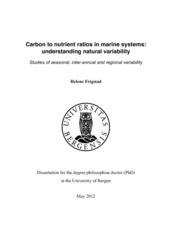Carbon to nutrient ratios in marine systems: understanding natural variability Studies of seasonal, inter-annual and regional variability
Doctoral thesis
Permanent lenke
https://hdl.handle.net/1956/5933Utgivelsesdato
2012-06-29Metadata
Vis full innførselSamlinger
- Geophysical Institute [1198]
Sammendrag
Ecological stoichiometry deals with the coupling of the carbon (C), nitrogen (N) and phosphorus (P) cycles at the base of the aquatic food webs. Variation in C:N:P stoichiometry is driven by a multitude of factors, and the aim of this thesis is to assess natural variability and identify the key drivers of seasonal, inter-annual and regional C:N:P stoichiometry. PAPER I focuses on the drivers of seasonal variation in C:N:P stoichiometry in two 20-year time series in the Skagerrak. The main result was that the suspended particulate organic matter (seston) was composed of less than 50% autotrophs at both stations. The sestonic fractions have contrasting C:nutrient ratios, which could result in an apparent Redfield stability over the season. Light intensity and spectral composition can affect the carbon to nutrient ratios in autotrophs, and uptake of 33P in three arctic diatoms exposed to ultraviolet radiation (UVR) was tested in PAPER II. The results emphasize the species-specific physiological responses of P uptake under UVR stress, and showed in general little support to the hypothesis of increased P uptake during UVR exposure. PAPER III deals with the long-term trends in carbon, nutrients and stoichiometry in the Skagerrak. The nutrient concentrations decreased over the 20-year time period, while the concentrations of C and N in seston, dissolved organic N and the nonautotrophic material all increased significantly and non-linearly between 1998 and 2000. These trends were connected to a reported “darkening” of the coastal waters in Skagerrak, and indicates that a regime-shift took place in the early 2000’s. Over 3600 observations of the C:N ratio in the Arctic and pan-Arctic shelves were analysed in PAPER IV, covering an area not included in previous meta-analyses of seston stoichiometry. The C:N ratio in most regions was significantly higher than the Redfield ratio, and showed significant non-constant behaviour, thus violating the assumption of a constant ratio between C and N.
Består av
PAPER I: Frigstad, H., Andersen, T., Hessen, D. O., Naustvoll, L. J., Johnsen, T. M. & Bellerby, R. G. J. 2011. Seasonal variation in marine C:N:P stoichiometry: can the composition of seston explain stable Redfield ratios? Biogeosciences, 8, 2917-2933. The article is available here: http://hdl.handle.net/1956/5932PAPER II: Hessen, D. O., Frigstad, H., Faerovig, P. J., Wojewodzic, M. W. & Leu, E. 2012. UV radiation and its effects on P-uptake in arctic diatoms. Journal of Experimental Marine Biology and Ecology, 411, 45-51. Full-text not available in BORA due to publisher restrictions. The published version is available at: http://dx.doi.org/10.1016/j.jembe.2011.10.028
PAPER III: Frigstad, H., Andersen, T., Hessen, D. O., Jeansson, E., Skogen, M., Naustvoll, L. J., Miles, M., Johannessen, T. & Bellerby, R. G. J. Long-term trends in carbon, nutrients and stoichiometry in Norwegian coastal waters: evidence of a regime shift. Manuscript in preparation. Full-text not available in BORA.
PAPER IV: Frigstad, H., Andersen, T., Bellerby, R. G. J., Silyakova, A., & Hessen, D. O. Variation in the seston C:N ratio of the Arctic Ocean and pan-Arctic shelves. Manuscript in preparation. Full-text not available in BORA.
